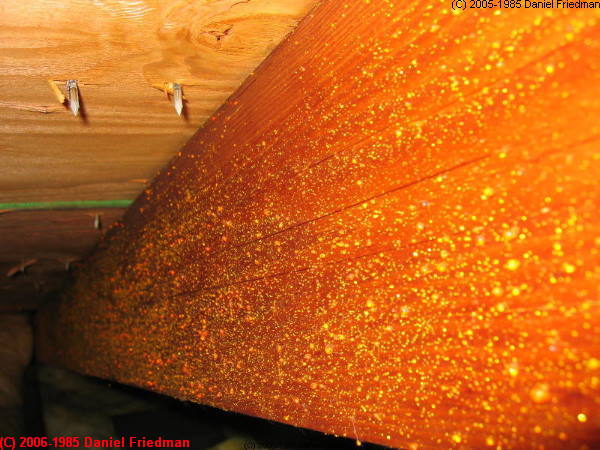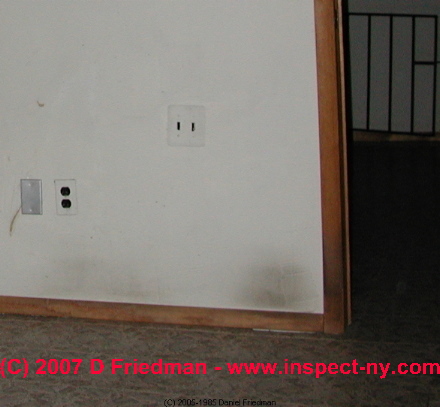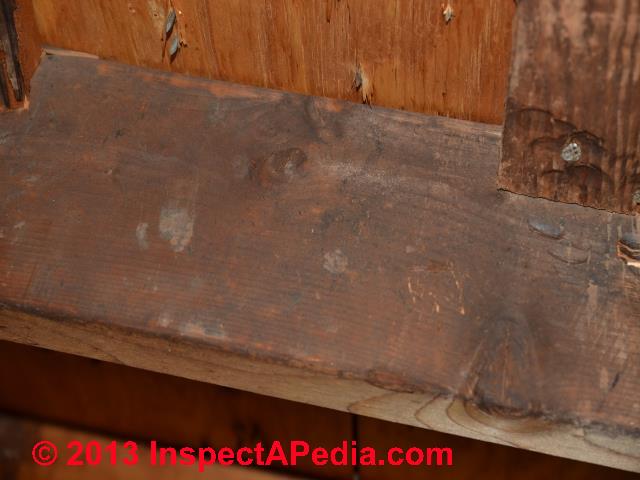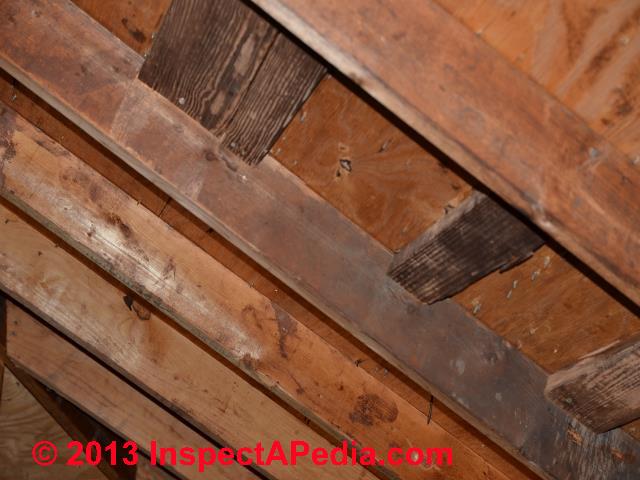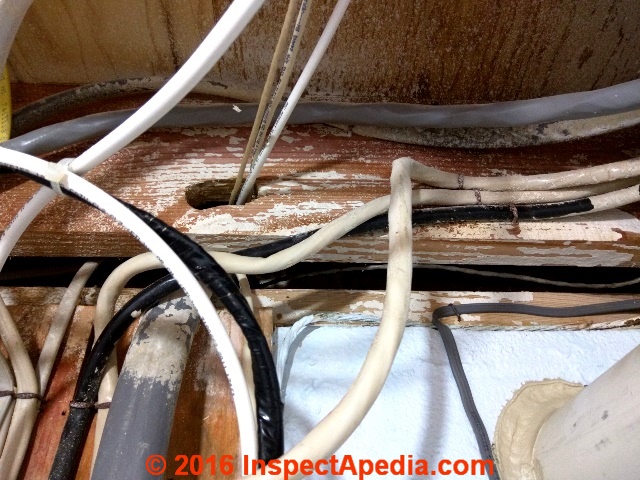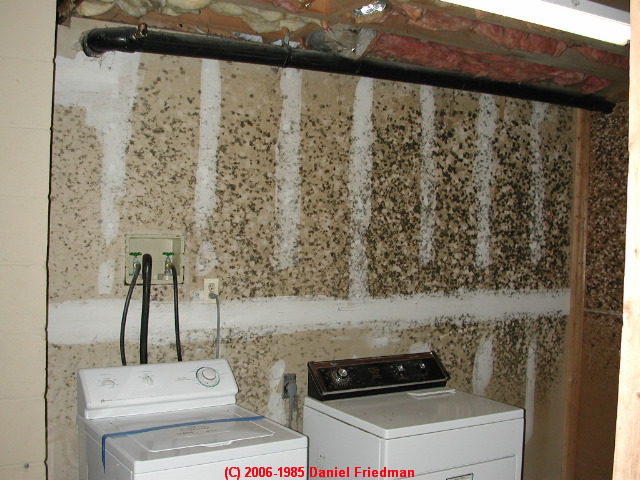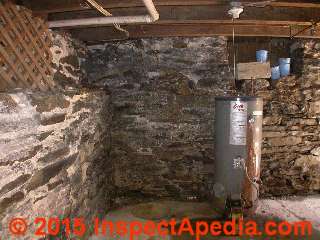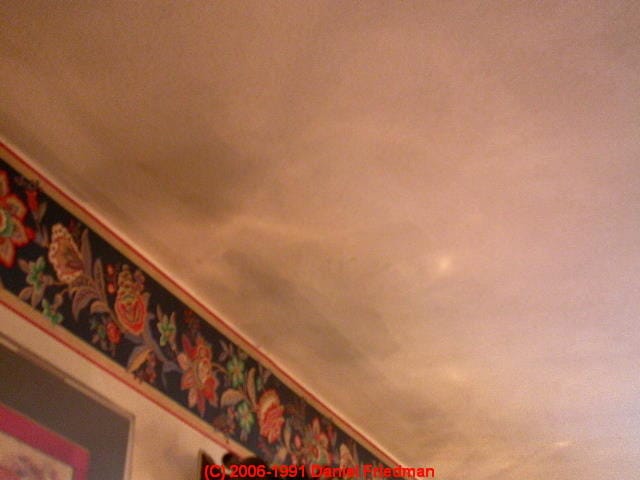 Stuff that is Not Mold Photographs
Stuff that is Not Mold Photographs
White fluffy crystalline deposits,
black stains, yellow stains, harmless black mold
& other diagnostic photographs
- POST a QUESTION or COMMENT about how to identify stuff in buildings that is not mold but may be mistaken for it. Stains, deposits, growths, etc.
Guide to distinguishing mold contamination from other building stains, debris, or particles.
This article describes indoor stains and deposits that are not building mold or in other examples, harmless cosmetic mold.
When investigating a building for a mold problem, you can save mold test costs by learning how to recognize Stuff that is Not Mold or is only Harmless Mold but may be mistaken for more serious contamination - save your money.
Because people sometimes send "mold test" samples to our lab that really should not have been collected, much less looked-at, I provide this library of photographs of things that are "not mold" and don't need to be tested.
These are substances that you can easily learn to recognize in buildings. Save your mold test money, and increase the accuracy of your mold contamination inspection or test for toxic or allergenic mold in buildings: review these items to learn recognize non-fungal materials or even possibly harmless cosmetic black mold often mistaken for toxic fungal growth.
InspectAPedia tolerates no conflicts of interest. We have no relationship with advertisers, products, or services discussed at this website.
- Daniel Friedman, Publisher/Editor/Author - See WHO ARE WE?
Harmless indoor particles, stains, deposits that are not mold.
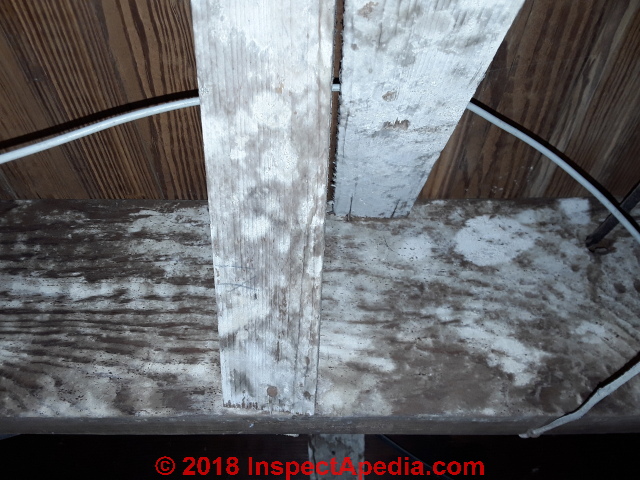 Here on this page are examples of scary-looking, usually harmless indoor stuff that is sometimes mistaken for mold.
Here on this page are examples of scary-looking, usually harmless indoor stuff that is sometimes mistaken for mold.
For photos of stuff that is indeed mold contamination in buildings,
see MOLD APPEARANCE - WHAT MOLD LOOKS LIKE. So many people have called us to look at things that are not mold that I'm offering some photo tips below.
[Click to enlarge any image]
Don't hire an environmental consultant if your only concern is the stuff you see here and if there are no health or air quality complaints. Save your money, don't bother testing the things you see below.
Finding "not mold" material in a building does not mean that there is no mold or allergen problem.
Even relatively harmless house dust collected on a surface and sent to a lab as a mold screening test can contain a surprising amount of problematic mold spores if the building has a mold problem.
More important for mold testing, right in among an old colony of harmless cosmetic black mold I've on often found hard-to-see Aspergillus sp. or Penicillium sp. mold that grew there much after the original black mold deposit.
Judgment and common sense are needed. Nonetheless, the examples below are unambiguous and should not be sampled for mold testing.
Photo: white deposits on floor framing over a basement of an older U.S. home were examined in our laboratory and identified as inorganic salts and minerals, possibly remains of a lime-based paint.
However water stains on some of the wood and a few chains of of Aspergillus sp. spores found in the surface samples from these joists suggested that a further check of other surfaces and materials to look for water damage and mold growth would be justified.
Article Contents
- BLACK STAINS - SOOT / THERMAL TRACKING
- BLACK STAINS - ANIMALS
- BLACK MOLD, HARMLESS COSMETIC
- HOUSE DUST
- POLLEN
- SPRAYED FOAM INSULATION
- WHITE DEPOSITS, DUST or STAINS in buildings, building dust, or found on building surfaces - not mold
- WOOD SAP - brown shiny stuff in attics
Review This List & These Photographs of Stains or Stuff in Buildings that Are Not Mold or Are Harmless Cosmetic Indoor Mold
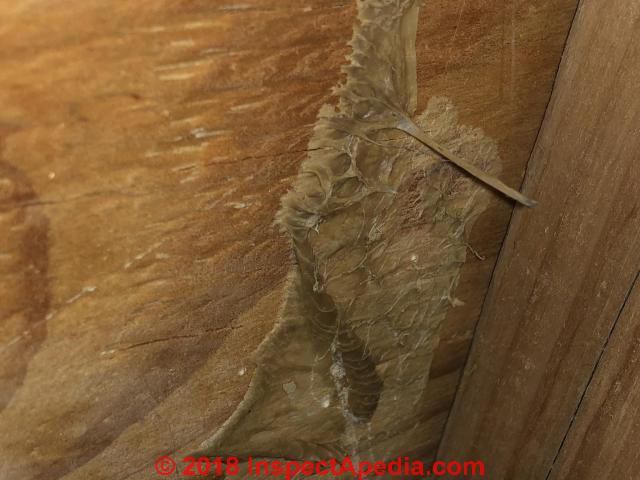 Photo: construction adhesive used to bond the plywood subfloor to the floor joists can get smeared or can drool and drip down into the space below. This photo, originally posted as a reader question
Photo: construction adhesive used to bond the plywood subfloor to the floor joists can get smeared or can drool and drip down into the space below. This photo, originally posted as a reader question
at MOLD CONTAMINATION IN BUILDINGS shows adhesive, not mold.
In the articles listed here we describe sometimes-scary-looking stuff on surfaces: but stuff that is not mold, does not require mold testing, but which may still help diagnose building conditions and history.
We discuss, describe, and provide photographs of some common items that are sometimes mistaken for mold in buildings.
- BASKETBALL MOLD SYNDROME - BBMS why dirt and stains may be mistaken for toxic harmful mold
- BLACK MOLD, COSMETIC On building surfaces that is harmless cosmetic material, not "toxic black mold" indoors
- BLACK INDOOR STAINS from SOOT or THERMAL TRACKING or marks on building interior walls caused by thermal tracking, this is not mold
- ANIMAL STAINS or marks on building interior walls caused by dogs, cats or other animal stains on building carpets, floors, walls, doors, trim: how to diagnose and remove pet stains and odors.
- BLACK COSMETIC MOLD - such as black stains due to Ceratocystis or Ophistoma fungi that were on framing lumber at the time of construction may be completely harmless, cosmetic only.
At BLACK COSMETIC MOLD we discuss some simple but reliable ways to identify cosmetic molds that have been present since time of building construction.
In our companion article,
RECOGNIZE HARMLESS BLACK MOLD, we discuss two specific harmless, cosmetic black molds commonly found on framing lumber. - EFFLORESCENCE SALTS & WHITE DEPOSITS white, tan, crystalline or bubbly, tan, or other-colored mineral salts on foundations and masonry walls - white fluffy stuff or white crystalline stuff often found on building walls may not be mold at all, though it is an indicator of problem leaks, moisture, dampness.
The article link on EFFLORESCENCE just above describes white fluffy crystalline material that is not mold.
WHITE MOLD PHOTOS describes actual white or light colored mold in buildings. - HOUSE DUST that may or may not contain mold, allergens, or other problems
- MOLD APPEARANCE - WHAT MOLD LOOKS LIKE - separate article
- POLLEN may contaminate indoor dust
- SPRAYED FOAM INSULATION- that looks a little like certain fungal growths in crawl spaces or other building areas, usually yellow or white in color
- STAIN DIAGNOSIS on BUILDING INTERIORS - home - lots of other stuff that's not mold
- THERMAL TRACKING BRIDGING GHOSTING - home - black marks on walls, ceilings, carpets, even insulation that may be mistaken for mold contamination
- WHITE STUFF that is NOT MOLD
includes EFFLORESCENCE or mineral salts found on damp or leaky masonry surfaces - WOOD SAP - clear or crystalline tan or yellow droplets found on wood framing, often in attics
Look for Efflorescence - Mineral Deposits (not mold) on Building Foundations and Masonry Walls
What about white fluffy "growth" or stuff on walls,
particularly masonry walls? You may be looking at efflorescence - which is not mold.
What about brown or even reddish or darker bubbly stuff
that seems to be "growing" on masonry or plaster walls? You may be looking at efflorescence - which is not mold.
Be sure to go to EFFLORESCENCE & WHITE or BROWN DEPOSITS to review our photos and text on how to recognize mineral efflorescence that is likely to be found on concrete block, stone, brick walls, foundations, and chimneys.
This white fluffy material is efflorescence, a crystalline mineral salt left behind as moisture comes through the wall and evaporates into the building interior.
Brownish or reddish bubbly efflorescence and dirt deposits on walls may be a mix of mineral efflorescence and other salts and debris left behind as water or moisture pass through building ceilings or walls.
Efflorescence is not mold, though it is an indicator of wet conditions that could contribute to a mold problem somewhere in the building.
In sum, although efflorescence is not mold, it often indicates wet conditions
that cause problem mold growth elsewhere in the same building.
You'll need to identify the sources of moisture or leaks and correct them, and depending on other building air quality complaints or health concerns it may be appropriate to inspect and screen the building for problem mold or other moisture or water-related problems.
How to Identify Wood Sap Crystals on Building Framing
What about those clear or opaque spherical brown blobs we see on rafters in attics? Is that toxic brown mold?
Probably not. Take a look at this photograph.
Wood sap on rafters [photo] in a hot attic forms hard shiny brown or tan spheres that some people think is mold.
It's not.
Here's a closer look at sap [photo]
This is not mold, it's sap crystals that have been extruded from the wood due to high attic temperatures.
We see more of this sap staining when the wood used for framing was not kiln dried before construction.
Mistaking sprayed foam for mold growth in buildings
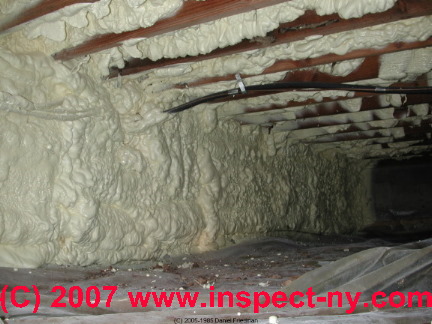 Some mold-suspect material in buildings is easily determined to be spray foam insulation.
Some mold-suspect material in buildings is easily determined to be spray foam insulation.
Sprayed icynene FOAM INSULATION [photo] is not mold either. Though we sometimes find fungal growth in buildings that looks a lot like this substance, it would be very odd for it to appear so extensively and so uniformly as the foam insulation shown in this photo.
For more information about foam spray insulation such as Icynene foam,
see ICYNENE FOAM SPRAY INSULATION and
for an older foam insulating product
see UREA FORMALDEHYDE FOAM INSULATION, UFFI
To compare actual mold growth with crawlspace foam insulation see this photograph of yellow mold growth [photo] taken from a rotting wood truss in a wet crawl space.
You'll see it looks a bit like the sprayed foam insulation shown on this page.
But actual yellow mold growth on wood won't be found in a continuous blanket such as shown in our photograph of icynene foam on this page.
See INSULATION INSPECTION & IMPROVEMENT for details about foam and other building insulation types;
see FIBERGLASS HAZARDS for a discussion of mold problems in fiberglass insulation;
see MOLD in FOAM INSULATION for a discussion of when and why we find mold growth on foam insulating materials like foam board and air handler foam insulating board.
How to recognize black stains that are thermal tracking or soot marks, not mold in buildings
![]()
THERMAL TRACKING BRIDGING GHOSTING - home
may be found where moisture condenses on cool building surfaces. Warm moisture-laden air touches the cooler surface of a building wall or ceiling, giving up some of its moisture to the surface as condensation.
As air moves through the building, typically up walls and across ceilings, debris in the air, particularly soot such as that left by burning scented candles, adheres more to the damp surfaces than to others, leaving black marks or "tracks."
In a conventionally-framed wood structure, wall and ceiling framing is typically on 16" or 24" centers.
The wall or ceiling will be cooler where the framing is located than will be the spaces which are not touched by framing and which, perhaps, are insulated.
So if you see black streaks up the building wall in a regular 16" or 24" pattern, particularly on cooler exterior walls but potentially anywhere, it may be thermal tracking.
If you have frequent fireplace fires, cooking, or if you burn scented candles, if people smoke in your home, or if your oil-fired or gas-fired heating system is not working properly, the added soot particle load in the building air is not only a health concern (soot and potentially lead), it also will mark the building surfaces in this characteristic pattern.
See our complete article on THERMAL TRACKING BRIDGING GHOSTING
Basketball Mold Syndrome (BBMS): How Old, Pre-Existing Building Conditions Can Be Perceived as Brand New and Threatening
BBMS is a term we coined for the phenomenon which describes an observer who is certain that a condition s/he has recently seen is a new condition even though solid forensic evidence shows that the condition is long-standing.
BBMS occurs when a person who has (other) reasons to be anxious about health or structural or safety conditions in a building (or any other condition where BBMS may apply) observes some mark, material, or substance for the first time
In other words, the condition or clue, mark, or substance was there before, but the person had no reason to attend, recognize, and consider it.
What Conditions Lead to BasketBall Mold Syndrome?
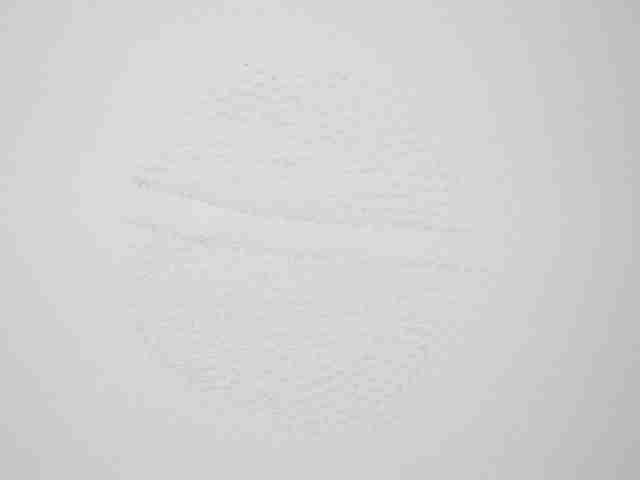 BBMS occurs most often (in our experience) where health concerns are present and people have become worried about mold contamination, or where structural concerns are present and people have become worried about cracks, stains, or possible indications of building damage.
BBMS occurs most often (in our experience) where health concerns are present and people have become worried about mold contamination, or where structural concerns are present and people have become worried about cracks, stains, or possible indications of building damage.
Basketball print mold:
A client was certain that a large collection of round black speckled marks on his garage ceiling were toxic mold, that the marks were growing in size, and that they had not been there when he purchased the home a few years before.
During a mold investigation we had seen and rapidly discounted the significance of these marks, preferring to follow water leaks and moisture to an actual building problem.
To an experienced eye it was immediately obvious that the marks had been made by a basketball which someone had bounced against walls and ceilings.
It is important to realize that a stain or mark may have been in place but un-noticed for a long time on a building surface.
In its form of black on white on the garage ceiling the stain pattern was a bit hard to see. We used this trick of reversing black and white in the lab computer, making the basketball characteristic surface pattern of the ceiling marks which we sampled quite obvious.
We explain why this confusion about building clues and mold risk happens in a separate page: please
see BASKETBALL MOLD SYNDROME - BBMS
Also see
- BLACK STAINS from ANIMALS for examples of animal stains that are sometimes mistaken for mold in buildings.
- COSMETIC vs HARMFUL MOLD: Can Mold Make You Sick? Fear of Mold - Mycophobia - Can Lead to Unnecessary Expense
- FOUNDATION DIAGNOSIS for examples of procedures used to diagnose and evaluate foundation wall and slab cracks and movement.
- MOLD INFORMATION CENTER for guidance on what to do about mold and other indoor air quality issues
- THERMAL TRACKING STAINS for a more detailed discussion of recognizing and diagnosing indoor stains on walls and ceilings, and for tips for using indoor stains to diagnose a variety of building problems and safety concerns.
How to recognize black stains on indoor walls and trim caused by pets, not mold
With a little thought we can easily distinguish pet stains on drywall from thermal tracking by the stain pattern and location as well as other details such as the absence of a heat source, or the identification of a location where we'd expect a pet to rest.
Similarly we can identify black stains on walls where people's heads rested while sitting on furniture or in bed (see photo link just below).
Black marks on interior walls [image] such as the black "mold suspect stains" shown on the white painted drywall in this photo might be just be where the dog [photo] lay on the floor against the wall (stain at floor level in this picture)
or in this photograph of black stains higher on a wall where people rested their heads [image] in bed.
Indoor House Dust Analysis Distinguishes Common from Problematic Mold and Other Particles
DUST, HVAC CONTAMINATION STUDY which turned out to be cotton and other carpet fibers having nothing to do with the Heating or Cooling equipment was discussed at
our Fear of Mold WebLog or "Blog" where we periodically post results of interesting forensic investigations.
House dust might be a contributor to building air quality complaints IF the dust has high levels of problem particles such as mold, dust mite fecals, pollen, sub-micron particulate debris, bacterial contaminants, pet hair, mouse dander or fecal dust, and similar particles.
The most common ingredients in house dust in a healthy home are:
- fabric fibers
- human skin cells
- starch granules, often from cooking and from bath products
- pet dander and pet hair, especially if pets live in the home
- non-fungal granular debris such as road dirt or soil particles
- at lower levels: common outdoor biological particles such as pollen and mold spores are present but generally at a lower level than outdoors (except when the windows are open), and the mix of these particles will be more heterogeneous than when mold spores appear indoors from an indoor mold reservoir;
we also may find certain outdoor mold spores only as individuals (such as Penicillium sp.) while if that same mold were growing indoors we may find it occurring as spore chains.
Pollen may be present in indoor dust reservoirs
POLLEN PHOTOGRAPHS provides advice including a pollen photo ID library. Pollen may be allergenic, but it's not mold and requires a different approach to detection and cleaning indoor spaces.
Cosmetic, Harmless Black Mold?
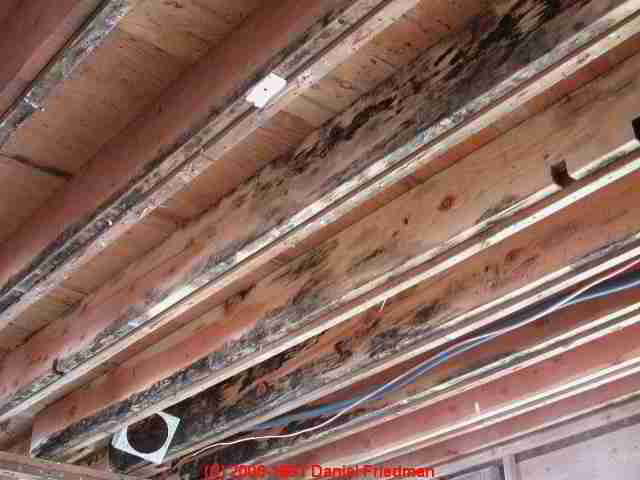
Some black mold in buildings arrived on the framing lumber and is harmless both to humans and to the building materials on which it is found. Often a visual inspection for certain clues (discussed below) can make you very confident of when mold appeared on lumber and what sort it probably is.
We discuss how to recognize and what to do about harmless mold, harmless black mold, and cosmetic molds in our article:
Make sure that the obvious harmless "black mold" you see (such as shown in the photograph at left) is the only mold growth found.
Dark stains on Wood - not mold
Photo-oxidation or weathering that affects wood left exposed to the weather can leave un-painted wood surfaces a gray or even a dark brown color.
We often see this effect on framing lumber that was left uncovered in storage or at the lumber yard. We may also see reddish-brown to gray oxidized wood surfaces on all sides of rafters in poorly-vented attics that have been very hot.
Characteristic of this wood coloration pattern is that just one side of the lumber - that exposed to sunlight - will be dark in color.
The following Q&A may be an illustration of this wood stain or oxidation question, though without a lab test we couldn't be sure that there was no mold on the treated wood (sometimes a host for fungal growth) or on other wood surfaces in the attic shown here.
Are the dark colors on these roof rafters indicative of mold contamination?
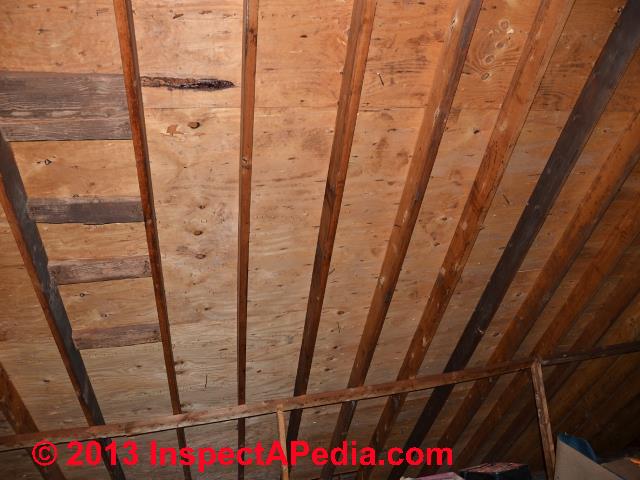
Do you think this is a mold problem on our roof rafter. L.P. 1/13/2013
Reply: probably not
A competent onsite inspection by an expert usually finds additional clues that help accurately diagnose a problem. That said, here are some things to consider:
What the heck - it looks as if that roof is framed over a very very long distance with just 2x6's
I can't be sure from just your photos, but from what I see so far one wonders if the roof is under-framed and lacks proper strength (photo above left).
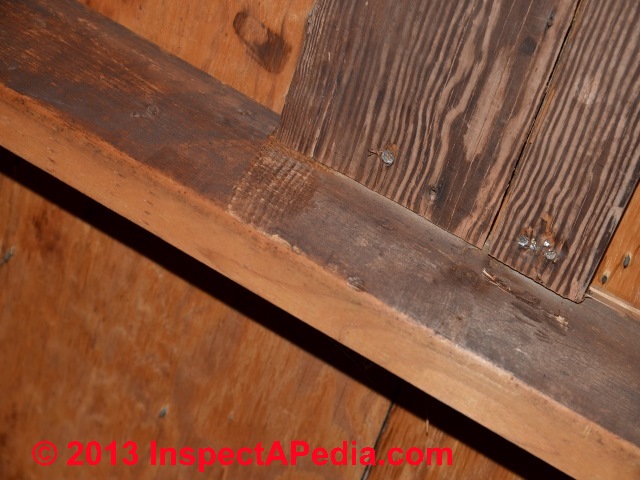
At above right we can see that someone banged in some additional support between existing rafters using what looks like treated lumber.
The fact that the dark color is just on one face of some rafters (photo at above left) and does not extend around the corner from the flat side to the rafter edge is NOT characteristic of in-situ mold growth - more like the wood was left outdoors and weather exposed before it was put to use
The fact that the dark color also does not grow over from rafter faces onto roof sheathing is a similar argument against mold growth on these surfaces since the time of construction
To know for sure what's on the wood surfaces would require a lab test or two. I wouldn't spend the money unless there were other reasons to be concerned about this area.
See MOLD / ENVIRONMENTAL EXPERT, HIRE ? for help figuring out if such investigation is warranted.
Other Interesting Indoor Stains that are (probably) not Mold
 Reader Question: dark growth on the underside of subflooring, visible from basement - in a fern-like pattern - is this toxic mold?
Reader Question: dark growth on the underside of subflooring, visible from basement - in a fern-like pattern - is this toxic mold?
I checked your site and I couldn't find anything on this. This is between the joists in my basement. I removed Sheetrock and insulation and found it. Thanks - M.R. 1010/17/2013
Reply:
With help from other experts, we believe these are marks left over from the removal of a bee hive. The fern pattern is where the honey comb connected to the subfloor.
Watch out: don't kill bees if you find them swarming in or around your home.
Given recent decimations of bee populations world wide we desperately need all the bees we can get. If you don't think there is a serious bee shortage, just take a look at people in China climbing trees with Q-tips to pollinate flowers on fruit trees. Call a bee expert for help.
How to Remove Honey Bee Swarms or Colonies from Buildings
See complete details as well as how this question and answer were resolved, now found
at HONEY BEES in BUILDING WALLS
White Stuff that is Not Mold in Buildings
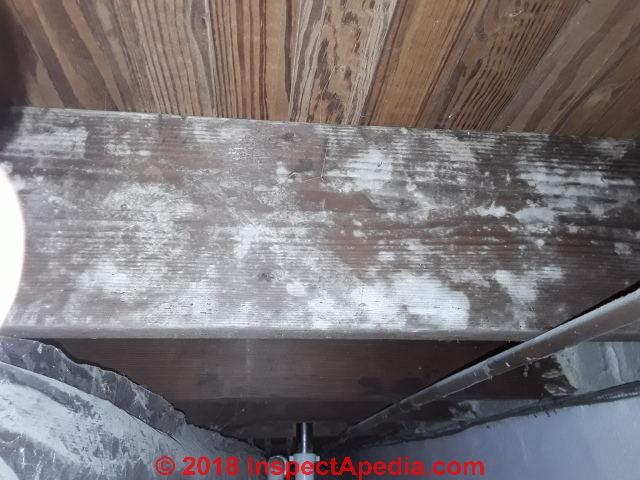 At the top of this article we showed another photo of these white deposits on wood floor joists in an older U.S. home. This is not mold but an inorganic deposit, possibly lyme paint or a similar coating.
At the top of this article we showed another photo of these white deposits on wood floor joists in an older U.S. home. This is not mold but an inorganic deposit, possibly lyme paint or a similar coating.
Similar stains or deposits can also be found on wood framing in a more gray color as cement deposit left on wood used first as concrete forms, later salvaged for use in building construction.
Earlier in this MOLD APPEARANCE - STUFF THAT IS NOT MOLD article
we describe efflorescence, or mineral salts found on damp or leaky masonry surfaces.
Other white deposits found on building surfaces may be
- White soot, ash, or dust from a fireplace or from some heating appliances.
Watch out: white deposits in or around gas-fired heating appliances and on or at gas burners may indicate improper operation and unsafe conditions, even risking dangerous or fatal carbon monoxide poisoning. - White paint or white paint overspray that we illustrate just below.
- Spider webs
- Water stains: see WATER STAINING CONTAMINANTS
- White house dust comprised mostly of light coloured fibres
- White stains on surfaces found outdoors:
- On or near chimneys: see CHIMNEY STAINS & LEAKS
- On roofs: see WHITE STAINS on ROOFS
- On stucco surfaces: see EFFLORESCENCE: WHITE BLOOM in STUCCO WALLS & PAINTS
- On walls: see STAINS on BRICK SURFACES where we include white run-down stains from aluminum siding trim, painted surfaces &c.
Question: white flaky crusty substance in my basement - is this keeping me from selling my house?
There is a white, flaky, crusty substance in my basement on the floor joists around the outside perimeter in the laundry and utility room. The pattern looks like mold, but the color is wrong. I posted photos on my Google Drive for public viewing. Short URL is ... .
I've had two home inspectors through the house in three years.
One for my pre-inspection before I bought the house, and one before putting the house on the market to sell. Neither one called it out.
But I'm over 90 days on the market with no offers, below market price in a good neighborhood, and wondering if this stuff may be scaring people away that are too polite to mention it.
Your feedback is welcomed.
[Click to enlarge any image]
Reply: no, white paint flakes would not usually be a sale deterrent
Lee:
The substance on the floor framing in your photos is not mold, it is a flaking-off white spray coating, I suspect either a paint or lyme coating.
Your first photo (above) shows the white spray pattern that coated the floor joists, rim joist, wall top framing, and continued across a vertical galvanized metal pipe.
It would be instructive to make a good guess at why the spray was applied. If there were insect damage, particularly powder-post beetles or old house borers (that I did not see in your photos) a coating is sometimes used to make more apparent whether or not the insects are active.
Above we can see paint flakes peeling off of the wood surface, and some peeling paint has fallen away completely, showing the wood surface of the floor joists. You may from time to time see more of these paint flakes on the floor below: the peel and fall-off rate probably depends on the moisture conditions in the basement as well as the paint age.
See PAINT FAILURE, DIAGNOSIS, CURE, PREVENTION for more about peeling paint on building surfaces.
If there was a history of basement water entry - an important concern to home buyers - someone may have sprayed paint to cover water stains or to paint-over a waterproofing sealant applied to the foundation wall below.
Having inspected thousands of homes over many decades, I have very rarely found conditions so severe that one would question the very idea of buying the home - perhaps 3 or 4 times in 8-10,000.
Every home inspection finds items in need of attention: conditions that are Dangerous, causing rapid Damage or Deterioration to the building, or that flat Don't work and are needed (Dan's "3 Ds").
A buyer needs to know about these in order to have a realistic financial plan for the home.
If a buyer likes the home, location, and price, I'd expect them to ask you or your realtor about any 3-D findings that result from the inspection, (even though their home inspector should have discussed his or her observations only with the person who hired him).
If your realtor is on the ball he will perhaps convey to potential buyers that you are open to hearing about and considering (in negotiation) legitimate findings or concerns that the buyers may have. That may make you better informed.
What does mold (of various colors and textures) look like on or in a building?
Be sure to see our full article: MOLD APPEARANCE - WHAT MOLD LOOKS LIKE that has photographs and descriptions of what real mold looks like inside a building.
But be careful, some of the most problematic common indoor molds, the Aspergillus sp. and Penicillium group can be very light in color and hard to see on building surfaces.
We offer tips on how to look for mold for these hard-to-see molds too:
If you need to see what other indoor allergens look like in a building contact us (our contact information is below and at the ARTICLE INDEX the bottom of this article ).
...
Reader Comments, Questions & Answers About The Article Above
Below you will find questions and answers previously posted on this page at its page bottom reader comment box.
Reader Q&A - also see RECOMMENDED ARTICLES & FAQs
Is this Mold?
Do you think it’s mold?
It’s in the basement, it is humid there - the landlord has the dehumidifier constantly on. The paint is also bubbly and is peeling is some spots. Please help! - On 2023-08-11 by Kalina
Reply by InspectApedia Publisher (mod)
@Kalina,
I'm not sure from your photo if we're seeing mold or simply water-damaged plaster or drywall or textured paint or mineral effloresence.
But if there have been leaks behind drywall walls or above drywall ceilings or trapped moisture there, there could be hidden mold in those cavities.On a closer look at the photo a third time, I think we may be seeing effloresence - maybe on a plaster surface. That would be a water or leak indicator.
Effloresence is a mineral salt - not mold, but the water that it hints-at could have caused hidden mold in a ceiling or wall. Don't panic - you're showing a very small area - if that's all there is. But do ake a look at
HIDDEN MOLD in CEILING / WALL CAVITY https://inspectapedia.com/mold/Hidden-Mold-in-Ceiling-Wall.php
Sticky surfaces in my bath: mold?
The surfaces in my small half bath keep getting sticky. It is a small bathroom on an outside wall that had a leak at one time.
There is no color to the stickiness, and a mold inspector says it isn't mold, but suggested that we clean the bathroom with a bleach and water mixture since there was a little mold in the window of that room. In less than a week, the floor is sticky, as is the toilet top.
The granite cabinet top doesn't feel as sticky, but it feels like there is a layer of something on it. This is the only room in the house with this problem. Could it be mold?
Are there any molds that can cause surfaces to become sticky? I don't want to be a doubter, but I have learned to question testing. - On 2023-05-13 by Marilyn -
On 2023-05-13 by InspectApedia Publisher - some mold genera & species can produce sticky goop
@Marilyn
Certainly we appreciate your questions. They're always welcome. Working together and debating things helps us both.
Yes certainly there are some mold genera & species that can produce sticky goop. One of my favorites is inky Coprinus. And Dallas there will be some motor generous species that like to grow on building materials and that might produce something sticky.
But you wouldn't find mold growth on a surface that leads you to feel a tacky surface when at the same time that surface looks uniform otherwise over its area and has no visible mold.
Usually on page search box to search this website for our article titled
Mold appearance what mold looks like
And take a look at those examplesAnd you're certainly right to question testing. Mold tests such as air tests, particle counts, swab and culture sampling are spectacularly unreliable when used alone without an expert and thorough building inspection.
White spots on drywall look like drips not mold
I rent a 1st floor apartment and the back of the apartment is underground. I run a dehumidifier 24/7 & maintain 40% humidity at all times.
I’ve lived here 3 years & never seen any evidence of mold but have occasionally smelled a faint mildew smell when it’s high humidity outside.
About 2 months ago I noticed some white spots on the lower half of the bathroom drywall near the toilet.
thought I had splashed cleaner on the wall, tried to wipe it up but the shadow of the mark remained. Yesterday the light shining on the wall made it very clear that there were lots of new spots that have a drip appearance and are three dimensional, almost web-y. (See picture)
This specific wall an interior wall attached to the exterior wall & is does not have any plumbing near it (aside from the toilet bowl but the water line runs the other direction.
I haven’t seen this while droplets anywhere else in the house. I’ve looked in cabinets and on furniture but can’t find any other locations.
I mentioned it to my landlord & he told me to clean it with vinegar & see if it comes back & then he’ll investigate more.
Can you perhaps tell by the photos if it is mold? - On 2023-04-25
by Susanna -
Reply by InspectApedia Publisher
@Susanna,
Those white drip shaped marks in your photo certainly do not look like mold.
They look more as if something has flashed on the wall or leached through It's surface.
Take a look at that white line of material at the bottom edge of the wallboard (in your photo) as it looks as if it could be the same white substance that's appearing as drip marks on the wall.
However if you smell mold, which you described as mildew odor, Then there is mold somewhere that might need to be removed.
If there's mold in a wall cavity it would most likely be because there has been a leak, perhaps a plumbing leak, or for a wall where you are sure that there is no nearby plumbing, perhaps a leak around a window.
Thinking about that can guide us in deciding the most-suspect area where we eventually do some outdoor visual inspection or indoor invasive inspecting by cutting a small opening.
From just your photo and description I don't think that's urgent.
Could this white stuff on the ceiling of our furnace room in a 1914 house be mould?
This is a photo of a 1914 home ceiling in the furnace room. The home has a stone foundation. Could this be mould? On 2023-01-12 by Rebecca -
Reply by InspectApedia Publisher - white spots may be from whitewash
@Rebecca,
Those white spots could be mold growth, esp. considering that this looks like an older home possibly with a history of basement water entry or dampness (please confirm with building age, location, leak history)
But take a look at the oblong shape of some of those white spots in my excerpt from one of your photos.
Does this home have a stone foundation? Was the foundation ever sprayed with whitewash?Followup by Rebecca
@InspectApedia Publisher, thank you so much. Yes, the home is from 1914 and the stone foundation appears to be parged--would that be whitewash?
On 2023-01-12 by InspectApedia Publisher - whitewash in this stone foundation
@Rebecca,
"Parging" means coating a surface with a skim coat of concrete or "cement" consisting of two parts brick sand and one part portland cement, mixed to a viscous consistency much like peanut butter that can be smeared over a wall surface.
Whitewash was a lime-based paint used in older homes as an inexpensive coating that sealed stone foundations (sometimes used on block foundations) and that was, for a time, deliberately painted onto wood surfaces as it was thought to improve fire-resistance.
You can see the *remains* of some whitewash in this stone foundation photo.
A stone foundation might have been whitewashed, later cleaned-off and parged, and the parging might be painted with whitewash or something else - or nothing.
Whitewash foundation coating is described in nice detail by Phelan in this repair guide
- Phelan, Vincent CARE and REPAIR of the HOUSE [PDF], building and Housing Publication BH15, U.S. Bureau of Commerce, Bureau of Standards, (1931), retrieved 2017/12/07, original source: nvlpubs.nist.gov/nistpubs/Legacy/BH/nbsbuildinghousing15.pd
Is this yellow stuff in our wet crawl space mold?
Is all this yellow stuff mold? Been very wet here recently. - On 2023-01-11 by Erik -
On 2023-01-12 by InspectApedia Publisher (mod) - yellow mold in crawl space
@Erik,
That does look like mold.
Be sure to read YELLOW MOLD PICTURES
Watch out: to be complete, check out our warnings about yellow mold at
MERULIPORIA HOUSE EATING FUNGUS
White circular ring spots on hardwood floor - wipe off but reappear
These circular ring spots have been appearing in my old hut refinished hardwood floor over the last couple years. They wipe away but then pop up again someplace else.
Only on our second floor, as our first floor is vinyl. Is this mold or something else?
How should I clean? I should note we do have exposed brick walls. Thank you! - On 2023-01-07 by Mara -
Reply by InspectApedia Publisher
@Mara,
I'm not certain but that looks more like a spill or splash or even bird poop than mold.On 2023-01-11 by Mara
@InspectApedia Publisher, Thank you so much for your swift reply. We do not have any birds in our home so I have to rule that out.
It appears around the house on the second floor hardwood in random spots. I wipe it only to find a similar one reappear elsewhere. Here’s another one for reference.
Any idea? They are always a radiating ring like in the photos.On 2023-01-11 by InspectApedia Publisher - circular white ring spots showing up on hardwood flooring
@Mara,
Thanks for the challenging floor "stain" problem.
I must agree that there is a consistent "round circle of white" pattern to those stains, though in your last photo I see what looks like a bit of the same white-gray material below the circular "stain".
It may be significant that these marks are appearing on more than one kind of flooring material.
Your photo from a few days ago shows what looks like wood plank flooring.
Your photo from today looks like a different floor.
What is the flooring material in that photo?
Are all of these floors solid hardwood?
What are the age and location of the building?
When you clean off these whitish deposits, is there any mark or discoloration left on the floor?
Do these wipe off with water or are you using a different cleaning material?
Can you smear the marks with a finger or is the substance hard?
After what time and with what occupancy or use of the space are these marks appearing after the floor has been cleaned?
Have you inspected everyone's shoes for possible contaminant that's being tracked indoors or tracked from another location on the same floor?
Can you collect a sample of the material on clear adhesive tape? If so, you might try using the procedure we describe at
TEST KIT for DUST, MOLD, PARTICLES: INSTRUCTIONS
and then find a forensic microscopy lab who will examine your sample to try to identify it. (I'd offer but I've retired from that service even on a pro-bono basis)
Ed.
White stuff on several spots of the wood ceiling - Kailua Kona, Hawaii.
 We noticed this stuff in several spots of the wood ceiling of our home in Kailua Kona, Hawaii.
We noticed this stuff in several spots of the wood ceiling of our home in Kailua Kona, Hawaii.
Any idea what this is? 2022-12-28 by Jon -
Reply by InspectApedia Publisher (mod) - spider or other insect web or nest
@Jon,
I tried to zoom in but the photo was a little blurry. So I'm not sure if we're seeing little spider webs or white fungus.
Followup by Jon
@Insp ectApedia Editor, thank you for your feedback. On closer inspection, I think you're right about it being spider webs. Thanks for your help!
Reply by InspectApedia Publisher (mod) - fluffy stuff on ceiling: spider web? Not mold!
@Jon,
Thanks for the discussion - the photo and notes will help other readers.
It's also useful to compare your photo to
inspectapedia.com/mold/White_Mold_Pictures.php
WHITE MOLD PHOTOS
If you've the energy to try to snap a very sharp photo that would be most-helpful.
We'll keep your photo and this discussion with this article.
On 2022-05-05 by Lesa
 I took the photo during a rain storm, and with a flashlight in hand, observed for a good 10 minutes to see if there's any drips or water leaving the boards or rafters.
I took the photo during a rain storm, and with a flashlight in hand, observed for a good 10 minutes to see if there's any drips or water leaving the boards or rafters.
Is it safe to say that if there was a leak of any volume, I'd be seeing it drip in that situation? I couldn't get close enough to feel the boards. Where I can see plywood between the boards, the plywood appears to be clear looking.
There's no evidence of water damage or leaking on any of the surfaces below the attic ceiling, but there's an old plaster ceiling that way left up there so the water would have a few layers to penetrate before I'd be seeing it on my second floor ceiling.
Also the immediate ceiling is lined with fiberglass batts. Looking at some of the rafters near the ridge, there's some sparkling quality- is that typically efforvescence?
When the roof was done 9 years ago, I didn't pay attention or know what I know now, and it appears the roofers put on a ridge vent but it doesn't appear open, as there's no daylight. There's one sizable gable vent open on the front but the previous owner blocked the back vent when an addition was added.
Soffit vents arent feasible (it was a Greek revival originally I believe) so the plan is to add an exhaust roof vent to draw from the Gable for intake. Im concered there's not enough ventilation, currently. I should maybe add that I'm located in upstate NY.
Thank you so much for your reply and feedback.
Reply by Inspectapedia Com Moderator (mod)
@Lesa,
The white blobs in some of your photos are remains of mud-dauber wasp nests that have been removed.
I think this home originally had wood shingles, with roof sheathing set spaced apart using pit-sawn boards. Consistent with the date you report.
We can see, between the boards, the plywood decking you report and that was added atop the original roof decking boards.
Those "mineral salts " may be just that if they're near were a masonry chimney is or was located. Mineral deposits are themselves harmless; what's important is the information they tell us about the home.
I see signs of a history of roof leaks - no surprise on an older home.
If you see that water stains are also on the under-side of the plywood then roof leaks have occurred after that material was installed.
The important questions are
- are there ongoing leaks that need to be fixed
- is there rot that needs to be repaired.
An experienced home inspector or contractor can answer the questions that I posed by direct inspection.
About ventilation you're correct that you don't have a working roof vent system and you have a faux ridge vent.
There are products that can provide thieves venting even when there's no soffit overhang. Search this website for roof ventilation to see a series of articles that describe different options.
Green fuzzy stuff on wood framing - mold?
It does flake off and I plan to take a sample to get it tested. Heres a photo for reference! On 2022-01-18 by Taz -
Reply by Inspectapedia Com Moderator (mod)
@Taz,
That looks like a roof rafter (upside down photo - not your fault) that has white, brown, black, and yellow-green (chartreuse) discoloration, all of which might indeed be mold.
If you can wipe some of it off with a finger it's probably mold growth. (Don't put a moldy finger in your eye)
Knowing the mold genera/species won't change what's needed one bit, but still can be interesting. If you decide to test do let me know what species are identified: I'd bet there are at least 3; if you're clever you can capture all 3 close to one another on a single bit of tape - MAYBE - cutting the lab cost from 3 to 1.
Remove the mold
Find and fix the cause
Does my 1964 North Carolina home have dry rot spores or mold
I am remodeling a bathroom in my 1964 home in North Carolina and one wall is stripped back to studs. The lower of the two top plates has an orangey / brown powder like substance on its surface (image attached). It is the full length of the plate. Where there are holes for pipes / wires it's not on the inside surfaces.
It hasn't spread to the upper plate and hasn't spread significantly to the studs (there are some very small localized patches elsewhere. It rubs off if touched and is a fine powder.
There plate is about 9' long and the substance is the full length. In the middle for about 2' there is historical water damage and wet rot has disintegrated both plates, but the leak is no longer present and that rot doesn't seem active.
Within the 2x6 wall below are two copper waste stacks, a cast iron drain stack, copper supply lines and the main breaker panel for the house with all of the wiring passing up through this plate.
I'm concerned in case this is dry rot spores or some kind of mold, but the way it's spread uniformly across this one plate in particular seems strange. I'm wondering if it could be some kind of treatment that has been applied to the wood?
Thanks,
Jonathan On 2022-11-22
Reply by InspectApedia (Editor) -
@Jonathan,
Usually when mold is on just 1 of two abutting wood surfaces, the explanation is that we offer at
COSMETIC MOLD, RECOGNIZE
please take a look and let me know what you think. That's where posting this question and photo would be most helpful.
At the very least it means the mold was on the wood at time of construction - but that does not mean that ALL such mold is harmless. Only that it hasn't continued to spread.
These spots on the ceiling really bother me - getting darker over time
We bought our home in 2018 and these spots on the ceiling have really bothered me. They seem to be getting slowly darker with time and I'd like to understand better what this may be. We aren't smokers, no excessive scented candle burning or worrying amount of smoke otherwise.
We have a wood pellet stove downstairs, this is above the stairs leading to the second floor. We have forced heat but only use the one stove to heat the house, and it takes a long time to feel the warmth upstairs.
The house was built in 1993 and I understand it was rented out to many people before us. I believe the attic is above this. Downstairs we have some spots/areas that look like ghosting in pattern.
This appears more like soot/dust than the standard presentation of mold, but with these ceilings being so high, I can't get close enough to say for sure. I would greatly appreciate any input. On 2022-11-20 by Jaclyn -
Reply by InspectApedia (Editor) - ghosting patterns not mold
@Jaclyn,
Take a look at THERMAL TRACKING BRIDGING GHOSTING
including some safety warnings there about sooting gas fired equipment that can be a dangerous carbon monoxide hazard - be sure you have working CO detectors.
and I think you'll recognize those ghosting patterns.
What your photo shows doesn't look like mold.
...
Continue reading at MOLD APPEARANCE - WHAT MOLD LOOKS LIKE - or select a topic from the closely-related articles below, or see the complete ARTICLE INDEX.
Or see MOLD APPEARANCE, STUFF THAT'S NOT MOLD - FAQs - questions & answers posted originally on this page
Or see these
Recommended Articles
- MOLD APPEARANCE on VARIOUS SURFACES - INDEX to return to the full list of photographs of the appearance of mold on various building materials & contents.
- MOLD APPEARANCE - STUFF THAT IS NOT MOLD
- BASKETBALL MOLD SYNDROME - BBMS
- EFFLORESCENCE SALTS & WHITE DEPOSITS
- THERMAL TRACKING BRIDGING GHOSTING
- MOLD / ENVIRONMENTAL EXPERT, HIRE ?
- STAIN DIAGNOSIS on BUILDING INTERIORS
Suggested citation for this web page
MOLD APPEARANCE - STUFF THAT IS NOT MOLD at InspectApedia.com - online encyclopedia of building & environmental inspection, testing, diagnosis, repair, & problem prevention advice.
Or see this
INDEX to RELATED ARTICLES: ARTICLE INDEX to MOLD CONTAMINATION & REMEDIATION
Or use the SEARCH BOX found below to Ask a Question or Search InspectApedia
Ask a Question or Search InspectApedia
Questions & answers or comments about how to identify stuff in buildings that is not mold but may be mistaken for it. Stains, deposits, growths, etc.
Try the search box just below, or if you prefer, post a question or comment in the Comments box below and we will respond promptly.
Search the InspectApedia website
Note: appearance of your Comment below may be delayed: if your comment contains an image, photograph, web link, or text that looks to the software as if it might be a web link, your posting will appear after it has been approved by a moderator. Apologies for the delay.
Only one image can be added per comment but you can post as many comments, and therefore images, as you like.
You will not receive a notification when a response to your question has been posted.
Please bookmark this page to make it easy for you to check back for our response.
IF above you see "Comment Form is loading comments..." then COMMENT BOX - countable.ca / bawkbox.com IS NOT WORKING.
In any case you are welcome to send an email directly to us at InspectApedia.com at editor@inspectApedia.com
We'll reply to you directly. Please help us help you by noting, in your email, the URL of the InspectApedia page where you wanted to comment.
Citations & References
In addition to any citations in the article above, a full list is available on request.
- ASTM International (2010). Standard Guide for Assessment of Fungal Growth in Buildings. Designation: D7338-10
- Atlas of Clinical Fungi, 2nd Ed., GS deHoog, J Guarro, J Gene, & MJ Figueras, Centraalbureau voor Schimmelcultures, Universitat Rovira I Virgili, 2000, ISBN 90-70351-43-9
- Gravesen S, Nielsen PA, Iversen R, Nielsen KF. (1999). Microfungal Contamination of Damp Buildings–Examples of Risk Constructions and Risk Materials. Environmental Health Perspectives, Supplements Volume 107, Suppl 3:505-8.
- In addition to citations & references found in this article, see the research citations given at the end of the related articles found at our suggested
CONTINUE READING or RECOMMENDED ARTICLES.
- Carson, Dunlop & Associates Ltd., 120 Carlton Street Suite 407, Toronto ON M5A 4K2. Tel: (416) 964-9415 1-800-268-7070 Email: info@carsondunlop.com. Alan Carson is a past president of ASHI, the American Society of Home Inspectors.
Thanks to Alan Carson and Bob Dunlop, for permission for InspectAPedia to use text excerpts from The HOME REFERENCE BOOK - the Encyclopedia of Homes and to use illustrations from The ILLUSTRATED HOME .
Carson Dunlop Associates provides extensive home inspection education and report writing material. In gratitude we provide links to tsome Carson Dunlop Associates products and services.


